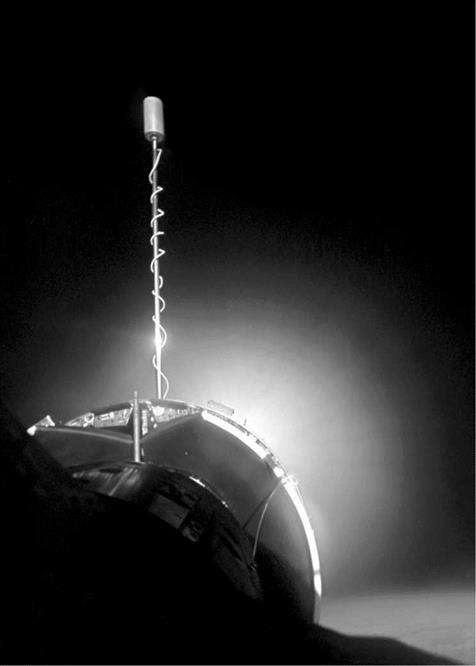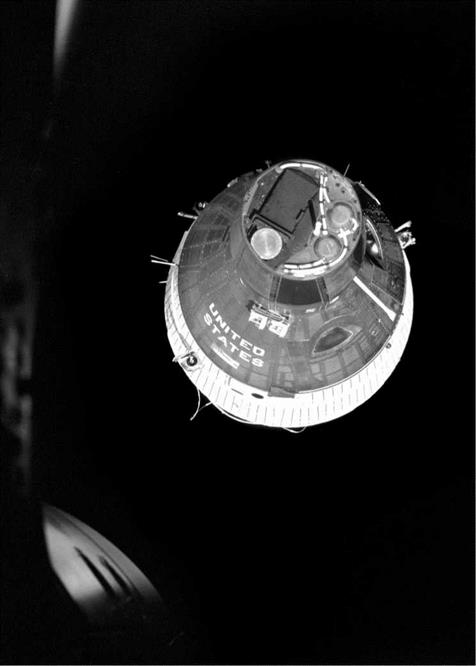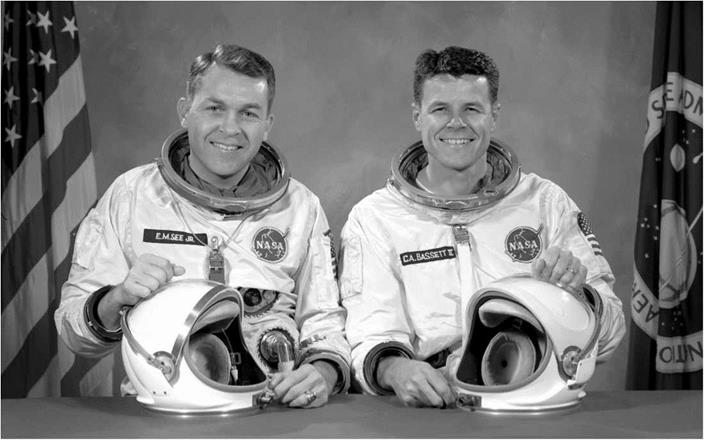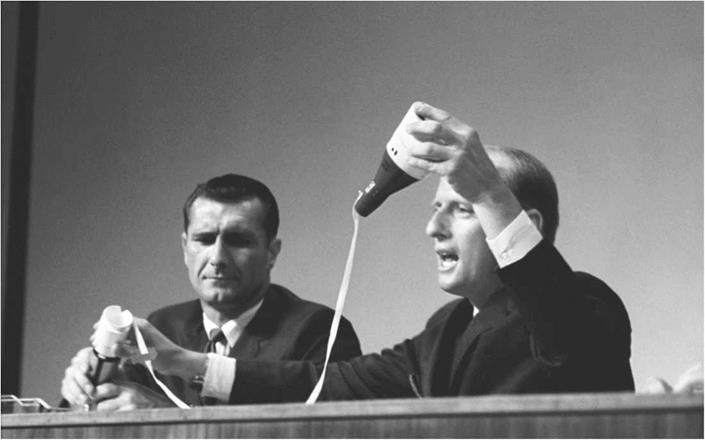Gemini X overcame many of the obstacles encountered by its predecessors; for during the course of Young and Collins’ three days aloft, the techniques of rendezvous, docking, spacewalking and boosting themselves into a higher orbit would all be successfully accomplished. Nor would Gemini X perform just ‘any’ rendezvous. Its crew would conduct joint activities with not one, but two targets: with their own Agena and, after raising their orbit to around 400 km, with the now – dead Agena left in space by Armstrong and Scott back in March 1966.
‘‘We were going to be navigational guinea pigs,’’ wrote Collins, ‘‘and were going to compute on-board our spacecraft all the manoeuvres necessary to find and catch our first Agena, instead of using ground-computed instructions to get us within range of our own radar.’’ To help them, Gemini X would have an expanded computer memory, known as ‘Module VI’, which required Collins to use a portable sextant to measure angles between target stars and Earth’s horizon. ‘‘Combining Module VI data with a variety of charts and graphs carried on-board,’’ he continued, ‘‘we would be able to determine our orbit and predict where we would be at a given future time relative to our Agena target.’’
The downside was that Module VI would operate in a totally different manner to Apollo’s navigation system, rendering it, in Collins’ words, a ‘‘technological deadend’’. Still, he and Young were being granted the test pilot’s dream job: to compute their own manoeuvres, autonomously of Mission Control, and the two men embraced it warmly. Yet there would be no avoiding the fact that completing all of their objectives in just three days would be a tough call. Young even approached Charles Mathews with a view to extending Gemini X to its four-day consumables limit, but his request was flatly rejected.
Young’s concerns, wrote Barton Hacker and James Grimwood, were twofold. Firstly there was the issue of whether he could slow the docked vehicles – his own Gemini and Agena-X – sufficiently to avoid hitting Agena-VIII and secondly was the very real possibility that he might be unable to find the second target using only onboard optical equipment. “The problem with an optical rendezvous,’’ Young said later, “is that you can’t tell how far away you are from the target. With the kind of velocities we were talking about, you couldn’t really tell at certain ranges whether you were opening or closing.’’
Moreover, since Agena-VIII was by now out of action and totally passive, Young and Collins and their Agena would need to be despatched from Cape Kennedy at very precise times, which presented its own problems should there be a launch failure or delay. By the opening months of 1966, a plan had crystallised: Gemini X would rendezvous and dock with its Agena during its fourth orbit, after which the second day of the mission would be dedicated to experiments and Agena-VIII operations would be deferred to the third day. Since many of its planned experiments could not be conducted whilst Gemini X and the Agena-X were docked, a happy balance of compromise would have to be struck between the engineering and scientific communities. In the eventuality that Young and Collins’ Agena, like that of Stafford and Cernan, should meet an unhappy end, it was decided to press on with the Agena – VIII rendezvous instead.
Preparations for Gemini X had gone relatively smoothly both before and after the assignment of the crew and their backups (Jim Lovell and Buzz Aldrin) in January 1966. In fact, when Young and Collins were named to the mission, their launch date did not change: they were scheduled for 18 July… and on 18 July, without a single delay, they would fly. The only change came in March, when Lovell and Aldrin were shuffled to the backup slot on Gemini IX and their places were taken by rookies Al Bean and Clifton ‘C. C.’ Williams.
Bean, who would one day become the fourth man to walk on the Moon, has been seen by some historians as an astronaut whose talent was overlooked by Deke Slayton; indeed, he would be the last of the surviving members of the 1963 class to fly in space. However, in his autobiography, Slayton vehemently disagreed. ‘‘Al was just a victim of the numbers game,’’ he wrote. ‘‘I would only point to the fact that he was the first guy from his group assigned as a crew commander. I was confident he could do the job if anything happened to John Young.’’ Ultimately, Bean would draw two of NASA’s best missions: a lunar landing and command of the second Skylab crew in 1973.
Meanwhile, the Titan II’s second-stage fuel tank had to be replaced with one previously earmarked for Gemini XI when a leaking battery caused some corrosion of its dome, but the remainder of the processing flow ran smoothly. After formal acceptance by Martin in mid-April 1966, the Titan’s two stages were shipped to Cape Kennedy late the following month, mated together and installed on Pad 19 on 7 June. Two days later, the Gemini X spacecraft itself arrived at the launch complex
|
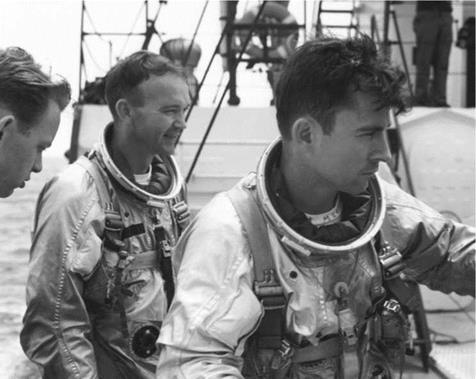
The crew of Gemini X: the gregarious Mike Collins (left) and reserved John Young.
|
and was attached to the top of the booster. Processing of the mission’s Agena target vehicle – designated GATV-5005 – proved similarly faultless and it was accepted by the Air Force and moved to the Eastern Test Range on 16 May. Nine days later, it was mated to its target docking adaptor and, following several weeks of further testing, was taken to Pad 14 and mounted atop its Atlas carrier rocket on 1 July.
There was no avoiding the reality that the Gemini X double rendezvous would be by far the most complex ever attempted. A late afternoon liftoff was necessary to intercept the Agena-VIII and, in the final few weeks, Young and Collins found themselves shifting their sleep patterns accordingly. “For the last couple of days,’’ Collins wrote, “we were staying up until 3 or 4 am and sleeping until noon. Granted, we were staying up studying, but somehow the late hours carried with them a connotation of leisure and relaxation.’’
They were awakened in their Cape Kennedy crew quarters around noon on 18 July 1966 and their Agena lifted-off without a hitch at 3:39 pm, barely two seconds late. It was followed promptly into orbit by the two astronauts at 5:20 pm. Collins would describe ‘feeling’ the rumble of the Titan, with minute sideways jerks, virtually no sensation of speed and, at first, a noticeable increase of little more than 1 G. The vibrations intensified as the rocket continued to climb, with mild pogo effects causing ‘‘a high-frequency quivering of body and instrument panel’’.
The violent shock of staging – as the Titan’s first stage, exhausted, fell away and its second stage picked up the thrust – was soon replaced by a sense of serenity as Gemini X headed towards its initial orbit. At one point, spectators at the Cape thought the rocket had exploded. In fact, it had. “An instant after the two stages separated,’’ Collins related, “the first-stage oxidiser tank ruptured explosively, spraying debris in all directions with dramatic, if harmless, visual effect.’’ The G forces gradually began to climb, peaking at close to 7 G, before ending abruptly when the Titan’s second stage shut down, precisely on time.
On the ground, Capcom Gordo Cooper flipped the wrong switch, opening the communications loop and allowing Young and Collins to overhear him summoning all launch personnel to a debriefing in the ready room. Collins radioed that he and Young were otherwise engaged and would be unable to attend.
There was much to do. Immediately after unstrapping, Collins unstowed the Kollsman sextant to begin the lengthy optical navigation procedure and Young manoeuvred the spacecraft into position to begin its six-hour pursuit of the Agena – X. Minor difficulties were encountered when Collins mistook the thin line of atmospheric airglow for Earth’s horizon, then could not get the lens of the sextant to work properly. He tried an Ilon instrument instead, with limited success.
Eventually, Gordo Cooper told the two men that they would have to rely on ground computations instead. More trouble, however, was afoot. When Young pulsed the OAMS thrusters to adjust Gemini X’s orbit to 265 x 272 km, he did not realise that the spacecraft was slightly turned, introducing an out-of-plane error, and needed to perform two large midcourse corrections. It was not Young’s fault, Deke Slayton wrote, because “there had been a mistake in loading the initial guidance program into the Gemini computer, so the spacecraft was never quite where the instruments said it was’’.
The computer had actually yielded a figure some 2 m/sec greater than that radioed up by Mission Control. Collins’ own slide-rule measurements agreed with Gemini X’s computer and, satisfied, Young opted to follow this double-checked on-board solution. Ten minutes into the OAMS manoeuvre, he quickly discovered that he had ‘overthrust’ the spacecraft and was heading into an orbital path several kilometres ‘behind’ and ‘above’ the Agena. He tried to ‘dive’ Gemini X back onto its correct trajectory through sheer brute force and succeeded in saving the manoeuve, but at the expense of losing a large quantity of fuel. Radar acquisition of the Agena-X was achieved during their second orbit. Young’s all-out effort to reach the target consumed 180 kg of propellant – three times more than any previous mission, leaving just 36 per cent remaining – but a successful docking was ‘in the bag’ at 11:13 pm, almost six hours after Gemini X’s launch.
The excessive fuel usage prompted Flight Director Glynn Lunney to abandon plans for ‘docking practice’, in which Young would have pulled away and then redocked with the Agena, and the astronauts were instead advised to press on with the Agena-VIII pursuit. In support of this goal, the Agena-X’s main engine roared to life, precisely on time, increasing the combined spacecraft’s velocity by 420 km/h and setting them on course. ‘‘At first,’’ Young explained later of the first ‘space switch’, ‘‘the sensation I got was that there was a pop, then there was a big explosion and a clang. We were thrown forward in the seats. Fire and sparks started coming out of the back end of that rascal. The light was something fierce and the acceleration was pretty good.” With abrupt suddenness, and precisely on time, the Agena-X’s engine shut down with what Young described as “a quick jolt’’. Since the Gemini and Agena were docked nose-to-nose, the firing propelled the astronauts ‘backwards’, producing so-called ‘eyeballs-out’ acceleration forces, as opposed to the ‘eyeballs-in’ experienced in a launch from Earth.
Comparing notes, Young and Collins both felt that the Agena’s acceleration and their change of direction – now travelling ‘backwards’ – were much greater than they had anticipated. The closest terrestrial analogy to the swift onset of thrust, they thought, was that it was similar to riding the afterburner of a J-57 jet engine, which Young had done as an F-8 Crusader aviator and Collins had experienced during his days flying the F-100 Super Sabre.
The first burn had effectively increased Gemini X’s apogee to 763 km, allowing the two astronauts to gaze down upon Earth from a greater vantage point than had ever been witnessed by human eyes; far higher than the 473 km achieved by Pavel Belyayev and Alexei Leonov aboard Voskhod 2. It also marked the first time that a manned spacecraft had employed the propulsion system of another vehicle to power its own flight, a technique which had important implications for future orbital refuelling. As they busied themselves with calculations for the remainder of the pursuit and rendezvous, they snapped photographs through the windows, including some of the Red Sea, and both would later recount that their home planet from an altitude of 763 km possessed a definite curvature.
Sleep posed its own problems for Collins. ‘‘My hands dangle in front of me at eye level,’’ he wrote, ‘‘attached as they are to relaxed arms, which seem to need gravity to hold them down.’’ Fearful that they may accidentally trip switches whilst asleep, he debated whether to tuck them behind his head (uncomfortable) or in his mouth (ill – advised), before finally telling himself not to worry. Such worries were further allayed by the two window shades, onto which had been pasted ‘‘photos of two voluptuous, wildly beautiful girls’’. Nursing a painful knee, Collins popped a couple of aspirin and tried with limited success to nap.
After their first restless night, the astronauts were awakened early on 19 July by updated computations for their next Agena burn, which Young duly executed for 78 seconds to reduce Gemini X’s velocity by 300 km/h and lower its apogee to 382 km. This second firing of the rocket’s engine impressed them both: after almost a day in microgravity, the 1 G acceleration, said Young, was ‘‘the biggest 1 G we ever saw!’’ Since the thrust was against the direction of travel, it produced a braking effect, after which a third firing circularised the orbit by raising the perigee to 377 km, barely 17 km ‘below’ Agena-VIII. At this point, they were trailing their target by less than 1,800 km.
In addition to the rendezvous commitment, the two astronauts also busied themselves with their load of experiments. Twenty minutes after reaching orbit, they activated the tri-axis magnetometer to measure radiation levels in the South Atlantic Anomaly, an area in which the lowermost portion of Earth’s Van Allen belts dip to within a few hundred kilometres of the surface. Elsewhere, two other devices – a beta
“The light was something fierce,” said John Young of the first Agena-X firing, “and the acceleration was pretty good.” Unfortunately, the astronauts’ view ‘outside’ was somewhat impaired by the bulk of the target vehicle.
spectrometer and a bremsstrahlung spectrometer – also monitored radiation dosages. “I only know that if I ever develop eye cararacts,” wrote Collins, “I will try to blame it on Gemini X.”
The radiation measurements, however, left investigators on the ground surprised and relieved. In fact, they were so disbelieving of the small numbers reported by the astronauts – 0.04 rad here, 0.18 rad there – that they mildly accused them of having their detectors switched off. In truth, radiation levels, even passing through the South Atlantic Anomaly, were much lower than anticipated. Several other experiments could only be done outside Gemini X and their deployment was one of Collins’ main tasks during the first of two EVAs on the mission.
Midway through preparations for his first excursion, Deke Slayton came on the radio, asking the crew to “do a little more talking from here on’’. Neither Young nor Collins was in any mood for idle conversation, having their hands full with systems checks, Agena commands, navigation and a 131-step checklist to get everything ready for the EVA. Young’s ho-hum response to Slayton’s request was typical: “Okay, boss. What do you want us to talk about?’’
Gemini X’s cabin atmosphere was completely vented to vacuum at 4:44 pm, approaching orbital dusk, and Collins poked his head out of the hatch three minutes later. His first period of extravehicular activity actually took the form of standing up on his seat, during which time he set up a 70 mm general-purpose camera to study stellar ultraviolet radiation. “It was not enough simply to lift the camera above Earth’s atmosphere,’’ Collins explained later. “It had also to be moved outside the spacecraft, because the protective glass of the spacecraft windows screened out most of the ultraviolet rays which the astronomers wished to measure.’’ As a result, Collins aimed the camera towards the southern Milky Way and scanned it from Beta Crucis to Gamma Velorum. In total, he acquired 32 images.
The view, even from his vantage point, hanging out of the hatch up to his waist, was astonishing. “The stars are everywhere,’’ Collins wrote, “above me on all sides, even below me somewhat, down there next to the obscure horizon. The stars are bright and they are steady.’’ Since it was now orbital nighttime, he could see little of Earth, save for the eerie bluish-grey tint of water, clouds and land. Minutes later, approaching dawn and with a rollful of 20-second ultraviolet exposures completed, he prepared to move onto his next task.
This involved photographing swatches of red, yellow, blue and grey on a titanium panel to determine the ability of film to adequately record colours in space. Unfortunately, Collins was unable to complete this objective in its entirety, when his eyes suddenly filled with tears; as, indeed, did Young’s. “That’s all we need,’’ Collins related, “two blind men whistling along with the door open, unable to read checklists or see hatch handles or floating obstructions.’’ They wondered aloud if a new antifog compound on the inside of their visors, added in the wake of Gene Cernan’s experience, had caused the irritation. Mission Control’s suggestion that perhaps urine had contaminated their oxygen supply was rejected by the astronauts, who described the odour as nothing of the sort.
Eitherway, the first period of EVA on Gemini X ended six minutes early, at 5:33 pm on 19 July. In total, Collins had been ‘outside’ for 49 minutes. It would later become clear that lithium hydroxide, used to scrub exhaled carbon dioxide from the cabin atmosphere, was mistakenly being pumped into the astronauts’ suits. Switching off a troublesome compressor device, wrote Deke Slayton, solved the problem. “I was crying a little all night,’’ Young quipped later, “but I didn’t say anything about it… I figured I’d be called a sissy!’’
Alongside the Agena-VIII rendezvous commitment, the astronauts’ third day in space was consumed with further experiments, though, thankfully, M-5, the much – loathed bioassays of body fluids task, which required them to collect, store and laboriously label their urine, was deleted from Gemini X’s roster. In fact, Charles Mathews had removed M-5 on 12 July, barely a week before launch, together with an experiment to measure the ultraviolet spectral reflectance of the lunar surface as a means of devising techniques to protect astronauts’ eyes from ultraviolet reflectivity. Other work included measurements of the ion and electron structure of Gemini X’s wake after separating from Agena-X and terrain and weather photography targets.
Undocking from their Agena came at 2:00 pm on 20 July, after almost 39 hours linked together, which both men found tiresome. Young would describe the sight through his window as a little like backing down a railway line in a diesel engine with “a big boxcar in front of you… the big drawback of having the Agena up there is that you can’t see the outside world’’. Their view with Agena-X attached, Young added, was “just practically zilch’’. After undocking, the view returned and, as Gemini X drew closer to Agena-VIII, Collins connected his 15 m umbilical and prepared to go outside for his second EVA.
Forty-five hours and 38 minutes into the mission, Young reported what he thought was his first visual sighting of Armstrong and Scott’s Agena, which actually turned out to be their own Agena-X! The other Agena, in fact, was still 176 km away, prompting Mission Control to tell the astronauts that it was “a pretty long range’’. Young, a little embarrassed, perhaps, at the mix-up, replied: “You have to have real good eyesight for that.’’ In fact, he and Collins did not get their first glimpse of Agena-VIII until they were 37 km away; the target resembled “a dim, star-like dot until the Sun rose above the spacecraft nose’’.
Two hours later, at 4:26 pm, Young initiated his final closure on the Agena, with Collins – whom the command pilot had nicknamed ‘Magellan’ during training for his navigational prowess – busily computing figures for two midcourse correction burns. The target, which had by now been aloft for four months, appeared very stable and Young was able to station-keep at a distance of just a few metres ‘above’ it, before moving in to inspect a micrometeoroid package that Collins was to retrieve. The rendezvous was accomplished entirely manually; the long-dead Agena was giving off no radar signals and its lights had long since stopped working. ‘‘They really just had to eyeball their way in,’’ recounted Deke Slayton.
Shortly thereafter, approaching orbital dawn at 6:01 pm, Collins cranked open his hatch and floated outside. In doing so, he became the first person to complete two EVAs. His first real movements ‘outside’ the Gemini were, he found, equally as difficult as those of Cernan: all tasks took considerably longer than anticipated. However, on this occasion, he was equipped with a zip-gun which aided his move over to the Agena-VIII and he crisply removed its micrometeoroid detector. He then
moved to Gemini X’s adaptor section and attached his zip-gun to the nitrogen fuel supply, before returning to the cabin as Young closed to within a couple of metres of Agena-VIII. Collins pushed himself away from the spacecraft, floated over to the Agena and grasped its docking collar with his gloved hands.
Discussions with Gene Cernan had already taught him that moving around and holding himself steady would be difficult and, indeed, Collins quickly lost his grip and drifted away from the Agena. Perhaps recalling Cernan’s problems, he decided not to rely on the tether and instead used squirts from the zip-gun – successfully – to propel himself 5 m or so back towards Gemini X, then back to the Agena. He was then able, with relative ease, to grab the micrometeoroid detector, known as experiment ‘S-10’, although he decided against installing a replacement device for fear that he might lose the one he had just retrieved.
His efforts accidentally sent Agena-VIII into a slight gyrating motion, which caused some consternation for Young, who was tasked with keeping the two spacecraft close together. Not only did Young have to keep a close eye on three independent ‘bodies’ – the Gemini, the Agena and Collins – but he was also trying to keep sunlight from falling onto the right-hand ejection seat in the cabin. If it heated up too much, its pyrotechnics might have fired, taking both of Gemini X’s hatches and Young’s own seat with it. Meanwhile, Collins moved himself, hand-over-hand, along the umbilical back to the Gemini and handed S-10 to Young.
Not so successful was Young’s effort to photograph Collins’ work. In fact, not a single image or frame of footage exists from what was a quite remarkable spacewalk. ‘‘I had four cameras,’’ he told an interviewer two decades later, ‘‘and none of ‘em were working!’’ Nor was Collins able to photograph a human being’s first contact in orbit with another spacecraft; his hand-held Hasselblad camera inadvertently drifted off as he was struggling to control his tether.
Next came a demonstration of the tether itself, extended to its full 9 m length, but this ended almost as soon as it had begun, when Mission Control told Young that he could not afford to use any more fuel for station-keeping. Young instructed Collins to return inside, which proved difficult because the spacewalker had gotten tangled in the umbilical and the rigidity of his suit prevented him from ‘seeing’ or even ‘feeling’ where it had wrapped itself. Finally returning to his seat after 39 minutes outside, Collins had to be helped out of the snake-like tangle by Young. Closing the hatch, thankfully, posed no difficulties. The EVA was, however, disappointingly short in duration; a consequence of Gemini X’s dwindling fuel supply.
Also disappointing was the loss of the micrometeoroid collector, which apparently drifted outside and away into space during Collins’ ingress back into Gemini X. It had contained 24 sample slides of materials including nitrocellulose film on copper mesh, together with copper foil, stainless steel, silver-coated plastic, lucite and titanium-covered glass, with the intention of exposing them to the harsh environment of low-Earth orbit.
Fuel woes were by now causing concern on the ground and the capcom asked them to confirm that they were not using any of their thrusters. An hour after Collins’ return inside, at 7:53 pm, the two men briefly reopened his hatch for three minutes to throw the tether – whose presence in the cramped cabin had made ‘‘the snake house at the zoo look like a Sunday school picnic”, according to Young – and the chest pack into space. Time was still tight and at 8:58 pm, they performed their next task: pulsing their OAMS thrusters to reshape their orbit, reducing their perigee to 106 km and rendering the point of re-entry more precise. After a few end-of – workday tasks, including more synoptic terrain and weather photographs, Young and Collins retired for their final night’s sleep in space.
Seven hours after awakening, at 3:10 pm on 21 July, Gemini X began its fiery plunge back through the atmosphere, high above the Canton Island tracking station on its 43rd orbit. During re-entry, Young was able to ‘steer’ his spacecraft’s banking angles by computer solutions and they splashed down in the western Atlantic at 4:07 pm, barely an hour shy of three full days since launch and just 5.4 km from the prime recovery vessel, the amphibious assault ship Guadalcanal. So close, in fact, were they to the intended splashdown point that the ship’s crew were able to watch Gemini X descending through the clouds beneath its parachutes.
After the installation of a flotation collar by pararescue swimmers, Young and Collins were helicoptered away to the ship for a red-carpet welcome, a band playing ‘It’s a Small, Small World’ and the inevitable medical checks. Their mission, together with that of Gemini IX-A, had addressed many questions which demanded answers before Apollo could go to the Moon: the demonstration of rendezvous methods, orbit-shaping manoeuvres to avoid trapped-radiation hazards in deep space and, of course, docking. Using Agena-X as a switch engine – in effect, a kind of‘space tug’ – also had untold ramifications for future spacecraft and the establishment of orbiting laboratories. In the next few days, the Agena participated in a number of remotely – commanded manoeuvres, boosting its apogee at one stage up to 1,390 km and eventually returning to a near-circular 352 km orbit.
Still posing an obstacle, though, was EVA, to which Collins now added his opinion: more and better restraints and handholds were definitely needed for spacewalkers to work effectively outside and operating in a rigidised suit was far more difficult than previously thought. ‘‘A large percentage of the astronaut’s time,’’ Collins related after the flight, ‘‘is. . . devoted to torquing his body around until it is in the proper position to do some useful work.’’ With only two more Gemini missions remaining, time was tight to get such problems resolved.












